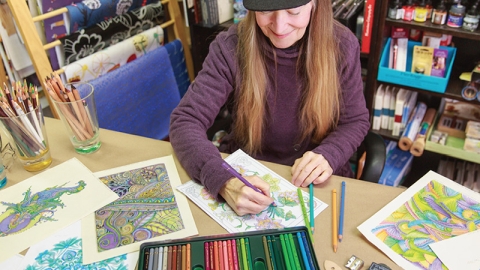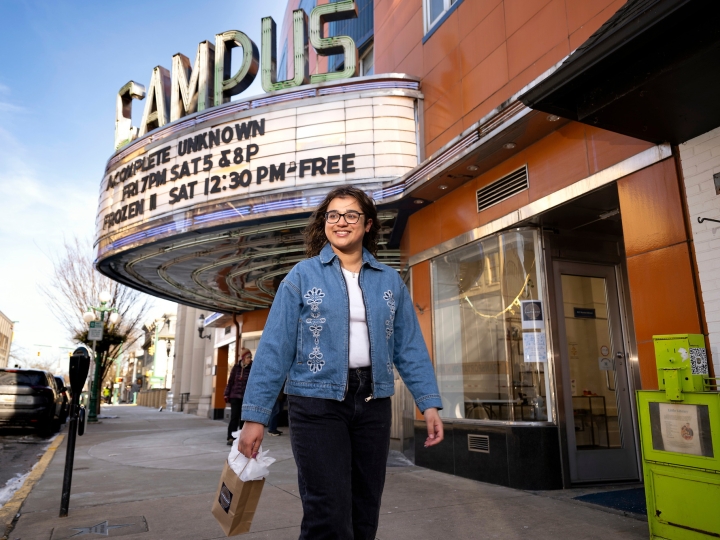
Living Color
April 16, 2016
Deb Slade '73 applies her pencils to a work in progress at Brushstrokes Gallery, Art Supplies and Framing in Lewisburg. Photo by Brett Simpson
In her scarlet tights with matching jacket and blue denim skirt, Bonnie Smith looks like she just walked out of a Crayola box. Asked about her reawakened passion for a childhood pastime, the academic assistant for the music department offers, "I'm fascinated with color." Her fascination extends beyond her fashion tastes and the stew of hues she selects for the music-event posters she designs — to coloring books.
"Most people are not surprised to hear I color," she says. "I'm a crafty kind of person. With coloring you can be creative in a nice little book that doesn’t take up a lot of space in the world."
Whether a newfound or rediscovered pursuit, adult coloring has taken off in the last two years and books with illustrations varying from tattoos to the masterworks of Van Gogh and Monet are flying off the shelves.
Customers strolling through the Barnes & Noble at Bucknell University Bookstore before Christmas espied a dazzling display. A month later, coloring books still graced the front of the store — on the bestsellers’ rack. In fact, two of Barnes & Nobles’ and 10 of Amazon’s top 20 books of 2015 were adult coloring books.
The surge began at Bucknell’s downtown Lewisburg store in July, according to Debbie Sheets, trade book manager. The catalyst, she says, was a TV appearance by Johanna Basford, whose 2013 book, Secret Garden: An Inky Treasure Hunt and Coloring Book, has helped power the adult-coloring fad.
"At Christmas, they went like wild," she says. "We actually ran out of the Harry Potter one before Christmas." Between early December and early January, she says, the store sold 200 coloring books, "which is really doing well. We've even had trouble keeping markers and pencils in stock."
Not only has Sheets become an avid buyer for her customers, but she’s put her own colored pencils to work. "I do it mainly to relax," she says. "I'll sit in my chair and the next thing I know I’ve fallen asleep. I’ve been coloring every night since September."
"And she’s so much calmer," jokes her boss, bookstore manager Don Royal, who doesn’t color but appreciates the business. Still, sales, he says, are "not like Fifty Shades of Grey hot," since customer tastes veer from Candy Crush to Creative Cats to Colour Me Good Benedict Cumberbatch. In early February, Amazon’s top sellers in the genre were the new arrivals, swear-word coloring books.
Across the street from Barnes & Noble, Brushstrokes Gallery, Art Supplies and Framing is also riding the many-hued wave. "This was our best December and we had the happiest customers ever," says co-owner Kathy Snyder, whose store has been in Lewisburg for 26 years.
Snyder began stocking coloring books about 15 years ago, when they were mainly purchased for nursing-home residents. "It’s something they can do when they can’t do a lot else," she says. Back then, they were called "grown-up" rather than "adult" to avoid an off-color connotation. Now Snyder can openly advertise on her streetside kiosk that she has hundreds of "adult" coloring books in stock.
Adults began clamoring for coloring books, she says, "after hearing Johanna Basford on NPR. People started thinking about coloring as a stress reliever." And while Snyder says her customers tend to be middle-aged women who color solo or with family members, she had three men pop in Christmas Eve to buy colored pencils for themselves.
Oftentimes, she’ll direct neophytes to her employee, Deb Slade ’73, resident expert. Colored pencils versus gel pens? Slade can help and she’ll gladly brandish her own coloring portfolio, demonstrating how to achieve different shadings and outlinings.
A former graphic designer at Bucknell, Slade says, "I came to coloring through Zentangle — meditative doodling." And she arrived at Zentangle through yoga.
"Coloring is like yoga for the brain," Slade says. "It’s focusing on something else besides the craziness in your life. You just go back and forth with your pencil," she says, slowly moving her hand.
Decades ago, as a Bucknell student, Slade colored with crayons "to de-stress, working in triads of colors." Now, rather than coloring in books such as Millie Marotta’s popular Animal Kingdom, Slade scans individual drawings from the books and prints them out on fine-quality paper. She’s even bought a lap desk with a light to illuminate the surface. The coloring craze, she says with a smile, "is very good for commerce."
It’s also good for travelers. Holly Valentine, AmeriCorps for youth outreach coordinator at Bucknell’s Office of Civic Engagement, brought Animal Kingdom along last summer on a North American road trip. "When I wasn’t rock climbing, I'd color," she says. "I’d even color while camping in the middle of Canada, sometimes at night with a head lamp."
Her office mate, Lynn Pierson, also has caught the coloring bug. When asked if anyone has accused her of being juvenile because she likes to color, Pierson says, "No, I believe it’s accepted as being in the mainstream." Pierson even recently queried Facebook friends about starting a coloring and wine group. The response has been very encouraging.
Like Deb Slade back in the '70s, current students also enjoy coloring. "I do it in my room and people either say, 'What is she doing?' or 'That’s kinda cool,' " says Louise Cerami-Guarino '16.
"What I like is there's no pressure," she adds. "The point is to take time for yourself and get your brain to stop thinking."
Mary Agrusti ’18 also gravitated to coloring. "I’m a huge art fan and love drawing but was a little skeptical of why people started getting into coloring," she says.
"It seemed that suddenly students had these large books with medallion prints and were coloring in random locations [around campus]," she says. "My friend just got me The Mindfulness Coloring Book and I love it. Coloring takes me out of the normal adult tasks that I get caught up doing and lets my mind almost lull while my colored pencils fill in the lines."
Like many other aficionados, custodian Connie Germini enjoys coloring, because "it lets your imagination go on and on." She relishes the freedom to choose an off-the-wall color for a common subject like a dog.
"It’s your dog; you make him any way you want," she says. Coloring is also a way to healthfully occupy one’s hands. "It’s better than munching on chips!"
Lest you think that coloring is only meant to clear the mind, unleash the creative urge or still the yen for munchies, at Bucknell there is even an academic dimension.
When Professor John Penniman, religion, saw Martyrdom: The Coloring Book at a Brooklyn bookstore in December, he added it to his syllabus for his spring course Dying for God: Martyrs & Monks.
"Building an assignment around a coloring book helps students see some of the bigger themes and questions about martyrdom in Christianity," he explains. The book’s left-hand pages provide a brief summary of a martyr’s life and death; on the right, the manner of death is illuminated. "Nearly every image depicts the moment of pain but also the piety," Penniman says. The martyrs are in pain but gazing upward.
"Coloring exemplifies how readers make sense of a text, not only by reading it but also by interacting with it physically, emotionally and intellectually," he adds. "Coloring helps them think about the process in a tactile way."

